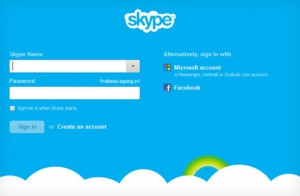According to today’s Guardian, Skype is being tackled by the data protection commissioner in Luxembourg over concerns it has secret links with the US National Security Agency, and its Prism communications intercept programme. Like many “interesting” companies such as eBay, Amazon and even Starbucks, Skype chose to be be based in the Luxembourg in the hope it would be left alone. However, the infamous tax haven’s constitutionally enshrined right to privacy might turn around and bite Skype.
 Microsoft bought Skype a couple of years ago; it had once been owned by eBay and, as a separate division, Microsoft has presumably decided to keep it in Luxembourg for the tax advantages. However, while Microsoft was allegedly one of the first large technology group to be pulled in to Prism, Skype has been widely thought of as a secure communications channel. If Luxembourg-based Skype has been passing intercepts to the NSA, its users and the local authorities will not be pleased.
Microsoft bought Skype a couple of years ago; it had once been owned by eBay and, as a separate division, Microsoft has presumably decided to keep it in Luxembourg for the tax advantages. However, while Microsoft was allegedly one of the first large technology group to be pulled in to Prism, Skype has been widely thought of as a secure communications channel. If Luxembourg-based Skype has been passing intercepts to the NSA, its users and the local authorities will not be pleased.
I understand that the local law does allow this kind of thing, and for it to remain secret, if it’s specially negotiated by the government. And as such the data commissioner may not have been in the loop.
But, you may wonder, how does an encrypted peer-to-peer system like Skype get intercepted anyway? The protocol was designed to pirate media files in such a way that lawful authorities were unable to track or disrupt it (which is why no network administrators would ever want it on their LANs). If it has weaknesses, they must have been there from the start. And I believe they were.
A few years back I was talking to someone from Facetime, a manufacturer of firewalls. They’ve since found that flogging their domain to Apple for an iPhone product is also lucrative, and now they’re called Actiance. But I digress.
Facetime had struck a deal with eBay to get details of the secret protocol so that they could manage Skype on local networks. As it’s obfuscated and designed to avoid firewalls, this is a neat trick, and they were the only people able to do it at the time. As an example, they were able to determine which versions of Skype were in use and block those that didn’t fit with company policy. In other words, they could positively recognise the obfuscated protocol and make sense of it.
According to the files the Guardian claims to have seen, Skype was ordered to cooperate with the NSA in February 2011, and it only took them a few months to have call intercepts in place. I’m not that surprised; given the Facetime firewall’s abilities I suspected that payload decryption was going to be possible if you asked the right questions whilst brandishing a big enough stick.
Making this information public, as is now the case, is simply going to push the people that should be intercepted on to systems not under the influence of the USA. How about a Chinese Skype-alike instead? Perhaps not, as it’s widely believed that the Chinese version has a back-door for the local authorities to plunder. But there are plenty of anarchist outfits out there with the ability to write a VoIP system that isn’t compromised by big business’s need to cooperate with governments if they want to make a profit.
Meanwhile, let’s see how Luxemburg’s data protection commissioner gets on.


 If you want to know what’s wrong with Skype see my chapter on VoIP in the Handbook of Electronic Security and Digital Forensics. Basically it’s a “stealth” protocol based on illegal file sharing technology (Kazza) and is almost completely unmanageable at firewall level. Apart from its use as a conduit for malware through a firewall, its anarchic super-node structure is a menace. It was designed, of course, to make it impossible for the authorities to shut it down peer-to-peer media sharing operations after Napster’s servers were clobbered, so the directory server (super-nodes) can pop up anywhere you get a luser running Skype. In summary, no one who knows about security would be happy about Skype running on their corporate network, and home users can go to hell in a handcart.
If you want to know what’s wrong with Skype see my chapter on VoIP in the Handbook of Electronic Security and Digital Forensics. Basically it’s a “stealth” protocol based on illegal file sharing technology (Kazza) and is almost completely unmanageable at firewall level. Apart from its use as a conduit for malware through a firewall, its anarchic super-node structure is a menace. It was designed, of course, to make it impossible for the authorities to shut it down peer-to-peer media sharing operations after Napster’s servers were clobbered, so the directory server (super-nodes) can pop up anywhere you get a luser running Skype. In summary, no one who knows about security would be happy about Skype running on their corporate network, and home users can go to hell in a handcart.